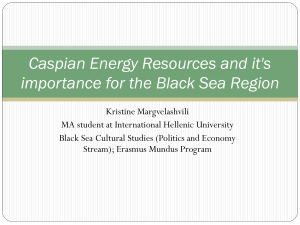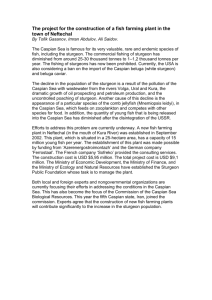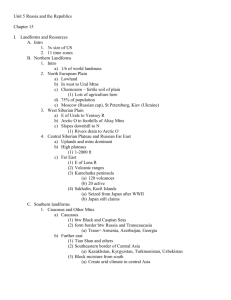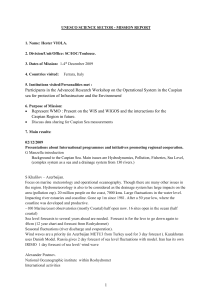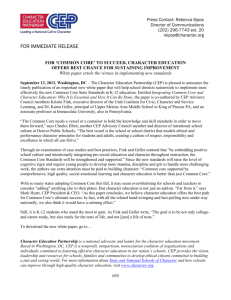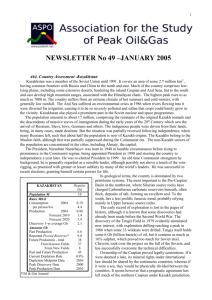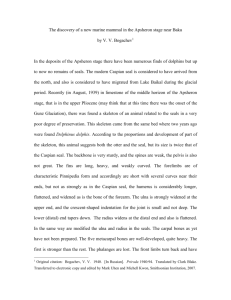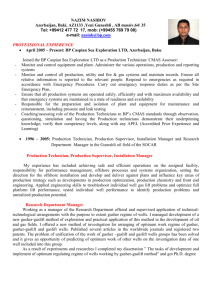1.3 Geographic and General Information
advertisement
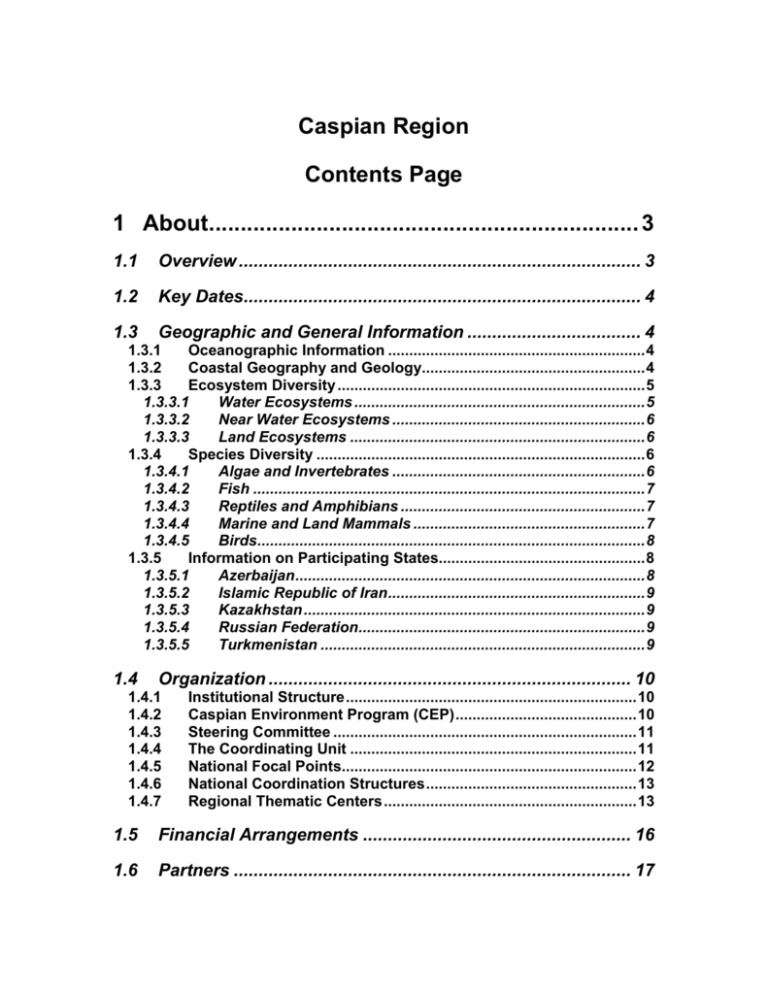
Caspian Region Contents Page 1 About.................................................................... 3 1.1 Overview ................................................................................. 3 1.2 Key Dates................................................................................ 4 1.3 Geographic and General Information ................................... 4 1.3.1 Oceanographic Information ............................................................. 4 1.3.2 Coastal Geography and Geology..................................................... 4 1.3.3 Ecosystem Diversity ......................................................................... 5 1.3.3.1 Water Ecosystems ..................................................................... 5 1.3.3.2 Near Water Ecosystems ............................................................ 6 1.3.3.3 Land Ecosystems ...................................................................... 6 1.3.4 Species Diversity .............................................................................. 6 1.3.4.1 Algae and Invertebrates ............................................................ 6 1.3.4.2 Fish ............................................................................................. 7 1.3.4.3 Reptiles and Amphibians .......................................................... 7 1.3.4.4 Marine and Land Mammals ....................................................... 7 1.3.4.5 Birds............................................................................................ 8 1.3.5 Information on Participating States................................................. 8 1.3.5.1 Azerbaijan ................................................................................... 8 1.3.5.2 Islamic Republic of Iran ............................................................. 9 1.3.5.3 Kazakhstan ................................................................................. 9 1.3.5.4 Russian Federation.................................................................... 9 1.3.5.5 Turkmenistan ............................................................................. 9 1.4 Organization ......................................................................... 10 1.4.1 1.4.2 1.4.3 1.4.4 1.4.5 1.4.6 1.4.7 Institutional Structure ..................................................................... 10 Caspian Environment Program (CEP) ........................................... 10 Steering Committee ........................................................................ 11 The Coordinating Unit .................................................................... 11 National Focal Points...................................................................... 12 National Coordination Structures .................................................. 13 Regional Thematic Centers ............................................................ 13 1.5 Financial Arrangements ...................................................... 16 1.6 Partners ................................................................................ 17 2 Our Work............................................................ 17 2.1 Programme Strategy ............................................................ 17 2.2 Action Plan ........................................................................... 17 2.3 Convention ........................................................................... 18 2.4 Issues and Threats ............................................................... 18 2.4.1 2.4.2 2.4.3 2.4.4 2.4.5 2.5 Habitat Loss .................................................................................... 18 Endangered Species ....................................................................... 19 Exploitation of Resources .............................................................. 20 Introduction of Alien Species ........................................................ 20 Pollution........................................................................................... 21 Current Activities ................................................................. 21 2.5.1 2.5.2 Fisheries Management and Sustainable Development ................ 22 Ecotoxicology ................................................................................. 22 3 Publications ....................................................... 23 3.1 Regional Seas Reports and Studies ................................... 23 3.2 Technical Reports ................................................................ 23 3.3 Other Publications ............................................................... 23 3.4 Meeting Reports ................................................................... 23 3.5 Website Links ....................................................................... 23 4 Calendar of Events............................................ 24 5 Professionals .................................................... 24 5.1 List of Technical Consultants ............................................. 24 5.2 List of Institutions ................................................................ 24 6 Advertisements ................................................. 24 7 References ......................................................... 25 1 About 1.1 Overview The Caspian Sea is the largest enclosed body of water on Earth. The long history and isolation of the Sea has left it with impressive biodiversity and more than 300 endemic species. It hosts 115 species of fish, including the famous sturgeons, a valuable economic resource for more than a century. The Caspian seal is one of only two freshwater seal species in the world. Extensive coastal wetlands offer a popular stop-off during migrations for many bird species, bringing eco-tourists. For these reasons and more the Caspian Sea region represents enormous economic potential for the region. Oil and gas production has been a feature here for more than 100 years and recent discoveries of new reserves have heightened the interest of the petroleum industry while sounding an alarm over the potential environmental effects of further development. The Sea already suffers from an enormous burden of pollution from oil extraction and refining, offshore oil fields, radioactive wastes from nuclear power plants and huge volumes of untreated sewage and industrial waste introduced mainly by the Volga River. Concern over the threats to the sea’s environmental health lead to the establishment of the Caspian Environment Programme (CEP) in 1999 by the five countries Azerbaijan, Iran, Kazakhstan, Russia and Turkmenistan. CEP aims to halt the deterioration of environmental conditions of the Caspian Sea and promote sustainable development in the area. The first phase of CEP began in 1998 with the main goals being: creation of a regional coordination mechanism to achieve sustainable development and management; completion of a Transboundary Diagnostic Analysis (TDA) of priority environmental issues to guide the necessary environmental actions; formulation and endorsement of a Strategic Action Programme (SAP) and adoption of National Caspian Action Plans (NCAPs). The participating countries demonstrated their commitment to protecting and restoring the Caspian environment by signing the Framework Convention on 4 November 2003 in Tehran, by approval of the Caspian SAP on the following day and by effectively pursuing the completion of the endorsement process of their NCAPs in accordance with the established procedures. CEP has achieved much in a short space of time. In the future CEP will focus on the four main areas of environmental concern: to protect and conserve biodiversity and reduce impacts of invasive species; to reduce levels of persistent toxic substances; to address sustainable use of bioresources, including fisheries; and to enhance sustainable coastal development. 1.2 Key Dates 1998 2002 2003 2004 Ramsar meeting held in Islamic Republic of Iran, CEP launched, May. Draft Convention finalised in July. The Framework Convention for the Protection of the Marine Environment of the Caspian Sea was signed by the five Caspian States at the Conference of Plenipotentiaries in Teheran, Iran on 4 November. 4 November, the Convention for the Protection of the Marine Environment of the Caspian Sea signed by all parties. 1.3 Geographic and General Information Region: Caspian Sea Participating States: Azerbaijan, Islamic Republic of Iran, Kazakhstan, Russia Federation and Turkmenistan Total Population: Length of Coastline: 7000 km (Stolberg et al 2003) Total Sea Surface Area: 386,400 km2 (CEP 2004) Total Volume: 78,700 km3 (CEP 2004) GIWA Regions: 23: Caspian Sea Map 1.3.1 Oceanographic Information The Caspian Sea is divided into three basins: the northern (27% of surface area), middle (38% surface area) and southern (39% surface area) (Stolberg et al 2003), in total 78,100 km3. The physical characteristics vary along it longitudinal extent. During the winter the northern part freezes whilst water temperature in the south remains 10-11ºC. However, in summer the difference in water temperature between the two parts is 1-2ºC (Stolberg et al 2003). The northern basin is highly influenced by freshwater inflow from the Volga and Ural rivers and has a very low salinity (0.1‰) while in the middle and southern basins the water is consistently brackish and varies between 10-13 ‰ (Stolberg et al 2003). The water balance in the Caspian Sea is dominated by river inflow and surface evaporation (Stolberg et al 2003). 1.3.2 Coastal Geography and Geology The Caspian Sea is the Worlds largest inland water body, which extends 1200km from north to south and contains more than 40% of the inland waters of the world. The water level of the Caspian Seas is currently positioned 27m below mean sea level and the sea and no surface outlets. The catchments area is 3.5 million km2. More than 130 streams and rivers flow into the Caspian seas with a total of 300km3 per year (Stolberg et al 2003). The major river basins in the region are the Volga, Ural, Terek, Kura, Sulak, Samur and Sefid-Rud (the rivers of the northern coast providing 88% of total river inflow) (Stolberg et al 2003). The Volga River contributes 80% of total inflow to he Caspian and is the longest river in Europe. The Volga delta on the northwest coast covers 10,000km2 (Stolberg et al 2003). A feature of the delta region are the so-called Baer knolls which are hillocks, between 3m and 20m in height, formed by the action of onshore winds on the river sediments (CEP 2004). Numerous small lakes can be found between the knolls and there is a complex system of channels with many islets (CEP 2004). The Kara-Bogaz Gol, situated on the eastern coast of the Caspian Sea is considered to be the largest lagoon in the world and is separated from the sea by sand bars (CEP 2004). Until 1980, Kara-Bogaz-Gol was one of the significant evaporative sinks for the Caspian Sea. At the beginning of the 20th century, the sea level was much higher and the strait between the Caspian Sea and Kara-Bogaz-Gol allowed a flow of 30 km3 of water per year to the smaller basin. During subsequent years, the flow consistently decreased due to reduced fluvial inflow and a fall in sea level (CEP 2004). A solid dam was constructed across the strait in 1980 in an attempt to retard any further drop in sea level. This dam effectively isolated Kara-BogazGol from the Caspian basin, thus preventing further outflow of water to the bay. This closure caused more than 40 km3 of water to be retained within the Caspian Sea and contributed an additional 11 cm to the rising water levels. As a result, the average yearly rate of sea-level rise increased by 2.5-2.7 cm (CEP 2004). 1.3.3 Ecosystem Diversity Ecosystems of the coastal strip of the Caspian Sea are in three mediums: water, nearwater and land (Kangarly 2000). Water ecosystems are marine and fresh-water, the latter in its turn consists of fluvial and lake ecosystems (Kangarly 2000). Land ecosystems comprise lowland forests, meadow steeps, shrubs, sandy and clayey semideserts and deserts (Kangarly 2000). Near water ecosystems, sometimes described as transient zones, are composed of water stagnant lands such as gulfs, littoral locations, lakeshores, channels and deltas. Often the land is repeatedly inundated. 1.3.3.1 Water Ecosystems Fauna in the Caspian Sea can be categorized into benthic (bottom dwelling) fauna and pelagic (open ocean) fauna. The most typical feature of the bottom fauna is the predomination of species of mollusks, micromelanides, polychetes, olygochetes, leeches, decapods (except for shrimps and crabs), turbellarian worms, Cumacea, sponges, pearlweed and others. Major benthos range on the surface of ground (epibenthos) and in the sediment (endobenthos) are usually composed of sponges, pearlweed, worms, barnacles, clams, mytilaster, dreissens, infusoria and nektobenthos (shrimps) and planktobenthos (copepods) (Copepoda), cladocerans and rotifers (Kangarly 2000). The members of the pelagic aggregation are vegetative and living organisms. The vegetative are composed of bacteroplankton (Mycobacyerium, Mycococcus, Pseudomonas, Micrococcus, Sarcina, Planosarcina, Pseudobacterium, Bacterium, Chromobacterium, Vibrio and Bacillus) and phytoplankton (Bacillariophyta, Chaetocerus, Thalassiosira, Coscinodiscus Melosira, Nitzschia and Coscinodiscus). Of the living oraganisms, zooplankton (Calanipeda aguae dilcus, Acartia clausi, Heterocope caspia, Podonevadne camptonux,and P.angusta), pelagic fishes and the Caspian seal (Kangarly 2000). The zooplankton is of heterogeneous composition, which includes Capsian species, immigrants of Arctic, Mediterranean and freshwater origins. 1.3.3.2 Near Water Ecosystems In the vast expanses of land that are subject to flooding, the vegetation of inundated areas consists of reeds (Phragmites australis) and glasswort – halophyte grass communities. Individual benthic organisms such as worms and mollusks live at these sites. Numerous birds inhabit coastal areas of the sea to nest and breed, land animals also visit these places to hunt and feed such as the swamp beaver, jackal, stripped hyena and otter (Kangarly 2000). 1.3.3.3 Land Ecosystems The eastern and northern parts of the Caspian coast encompass the ‘Caspian lowland desert’ with sand dunes, salt deserts (solonchaks) and clay deserts (takyrs). Vegetation is sparse and dominated by salt tolerant plants forming shrubs (Stolberg et al 2003). The southern Caspian coastal zone consists of narrow lowlands, almost entirely cultivated which progress to the west where the Caucasus Mountains rise (Stolberg et al 2003). The desert and semi desert consists mainly of types of wormwood and shrubs, mammals, insects, birds etc. Lowland forests are composed of a variety of vegetation (e.g. Quercus Longipes., Caspinus caucassica) and are characterized by great variety of land mollusks, insects, amphibians and reptiles (Kangarly 2000). 1.3.4 Species Diversity The Caspian Sea is characterised by many endemic species. The existence of shallow areas, several deep depressions and a wide range of salinities varying from 0.1 –13 ‰ provide different ecological niches which gives rise to high species diversity (Stolberg et al 2003). The highest number of endemic species is found in the middle part whereas the greatest diversity is found in the northern part (Stolberg et al 2003). 1.3.4.1 Algae and Invertebrates The total number of phytoplankton species in the Caspian Sea is 441 of which 17 are endemic (Stolberg et al 2003). Of these the species distribution is; diatoms – 149, green – 138, blue-green – 90, pyrophyte – 32, euglena – 4, yellow-green – 1 (Caspian Sea, 1985 cited in Kokshetau 2000). The zooplankton is of heterogeneous composition, which includes Capsian species, immigrants of Arctic, Mediterranean and freshwater origins. The total number of zootoplankton species is 315 of which more than 64 are endemic (Stolberg et al 2003). The total number of zoobenthos species is 380 of which 190 are endemic (Stolberg et al 2003). The Caspian Sea also harbors 53 endemic species of mollusks (Stolberg et al 2003). The most numerous amid invertebrates of the Caspian Sea are flagellates, infusoria, roundworms, rotifers cladocerans and freshwater shrimps, whose total number constitutes 734 species or 52,6% of the total invertebrates of the sea. The role of these animals in the ecosystem of the Caspian Sea is enormous. They participate in selfpurification of seawaters, in majority they serve as a fodder base for fishes, birds and other animals (CEP 2000). 1.3.4.2 Fish The Caspian Sea harbors 133 species of fish (of which 54 species are endemic) and is famous for its population of anadromous sturgeons, which account for some 85% of the Worlds entire population at its peak in the mid 1980s (Stolberg et al 2003). Sturgeons are distributed through all of north-eastern Caspian (Kokshetau 2000). Other species include lamprey, herring, salmon, pike, carp, loach, catfish, stickleback, cyprinodonts, silverside, snakehead and perch (CEP 2000). Through a system of channels, connecting the Caspian with other southern and even northern seas, some gobies, pipefish and eel invaded the Caspian (Caspian Fisheries, 1997 cited in Kokshetau 2000). Chum, two species of mullets, Chinese phytovirous and the mosquito fish were also introduced (Kokshetau 2000). 1.3.4.3 Reptiles and Amphibians 31 species of reptiles were found on the coastline of Turkmenistan. The most widespread are: the Grey monitor, Marsh turtle, Caspian tortoise, Central Asian tortoise, Water snake, Central Asian cobra, Carper viper, Eryx miliaris, Spalerosophis diadema, Psammophis lenolatum, Plate-tailed gecko, Comb-toed gecko, Phrinocephalus helioscopus, Trapelus sanguinolentus, Eremias velox, etc (CEP 2000). Two species of amphibians can be found on the coastline of the Caspian Sea, Green toad that inhabits waterfronts and is associated with lentic waters and the Lacustrine frog, found only in running water (CEP 2000, Kokshetau 2000). 1.3.4.4 Marine and Land Mammals A total number of 125 marine and land mammals are found in the Caspian Sea of which only 1 is endemic, the Caspian Seal (Stolberg et al 2003). The Caspian seal is one of only two freshwater seal species in the world. The Caspian seal from the genus Pusa (Phoca caspica), inhabits the Caspian and is found throughout the year, however, their numbers are declining. In summertime, they are mainly pelagic. During this period their population reaches 70-80 individuals on the Mikhaylov’s islands and the Krasnovodsk spit. Just a few seals occur in the recreational zones, in the vicinity of Avaz and Thermoelectric power plant on the coastline of Turkmenistan (CEP 2000). In wintertime, the Caspian seal forms considerable concentrations in northern parts within Kazakhstan waters (Kokshetau 2000). There is a huge variety of land mammals associated with coastal wetlands and ecosystems, some examples are: the Eared hedgehog, Tolai hare, Jungle cat, Sand cat, Great gerbil, Hairy footed jerboa, Goitred gazelle (CEP 2000), wolf, golden jackal, badger, steppe cat, fox, weasel, steppe polecat, bobcat, stripped hyena and otter (Kokshetau 2000). 1.3.4.5 Birds The wetlands in the region play a major role as feeding and resting areas for migratory birds. The Caspian lies at the crossroads of migration routes and it has been estimated that up to 10 million birds stop over in the region each year during spring and autumn (Stolberg et al 2003). The Caspian Sea harbors a total number of 466 species of birds (Stolberg et al 2003). On the eastern coast of Turkmenistan some 80 bird species are found for example 1 species of Divers, 4 species of Grebe, 2 species of Totimplate birds, 2 species of Gressores, 1 species of Flamingo, 22 species of Lamellirostral, 2 species of Goshawk, 4 specoes of Meadow chicken, 13 species of Gulls, 26 species of Shorebirds, 1 species of Coraciformes and 3 species Sparrow (CEP 2000). The eastern Caspian wintering grounds of the Khazar reserve are on route of migration of West-Siberian, Caspian and Nile populations of waterfowls and water-loving birds, being a transit point during migration and the biggest wintering ground in Paleo-Arctic (CEP 2000). 278 species of birds are found on the northern coast of the Caspian Sea. Of these, 110 species are nesting, 76 species wintering and 92 species are birds of passage. Up to 3m ducks, 500 thousands geese, 35 thousands flamingos, 20 thousand swans, 100 thousand ducks and 10m sandpipers migrated trough northern and north-eastern Caspian coast. Mute swans, grey lag geese, river ducks, diving ducks, sandpipers, gulls, terns, cormorants, white pelicans, Dalmatian pelicans and herons nest in rush belts of northern and north-eastern coast of the Caspian Sea (Kokshetau 2000). 1.3.5 Information on Participating States 1.3.5.1 Azerbaijan Total Population: 8,184,340 (World Bank 2002) GDP per capita (PPP US$): 6,089,916,000 (World Bank 2002) Length of Coastline: 800 km along the Caspian Sea (CIA 2003) 1.3.5.2 Islamic Republic of Iran Total Population: 65,540,224 (World Bank 2002) GDP per capita (PPP US$): 107,522,236,416 (World Bank 2002) Length of Coastline: 740 km along the Caspian Sea (CIA 2003) 1.3.5.3 Kazakhstan Total Population: 14,794,830 (World Bank 2002) GDP per capita (PPP US$): 24,205,031,424 (World Bank 2002) Length of Coastline: 1894 km along the Caspian Sea (CIA 2003) 1.3.5.4 Russian Federation Total Population: 144,070,800 (World Bank 2002) GDP (current US$): 346,519,900,000 (World Bank 2002) Length of coastline: 37,653 km in total (CIA, 2003) Marine Protected Areas: 6 Nature Reserves. Existing MPAs are as follows (Simard 2003): Dalnevostochny Morskoy; Lasovsky; Sikhote-Alinsky Biosphere Reserve; Kurilsky; Kronotsky Biosphere Reserve; Dzhugdzhursky. Proposed New MPAs: Great Peter Bay (Zaliv Petra Velikogo); Kuryl Islands, including the Island of Kunashir, Shikotan, Iturup (Etorofu) and Habomai Archipelago; Komandorskiye Islands. 1.3.5.5 Turkmenistan Total Population: 5,545,360 (World Bank 2002) GDP per capita (PPP US$): 7,671,784,448 (World Bank 2002) Length of Coastline: 1768 km along the Caspian Sea (CIA 2003) Coastal Reserves: The Khazar Reserve; Ogurchin Reserve. (CEP 2000) 1.4 Organization 1.4.1 Institutional Structure Steering Committee National Focal Points Advisory Group National Coordination structure Intersectoral coordination Group Coordinating Unit Trust Fund Projects UNEP and other donor agencies 1.4.2 Caspian Environment Program (CEP) The objective of the CEP is to halt the deterioration of environmental conditions of the Caspian Sea and to promote sustainable development in the area. Issues include the following: Public awareness and involvement in the CEP. Effective regional intersectoral (public and private sectors) coordination and environmental management. Regional data and information management systems. Transboundary biodiversity priorities. Integrated transboundary biodiversity priorities. Sustainable human development and health. Institutional, legal, regulatory and economic frameworks for the implementation of the regional Strategic Action Plan. Strengthen contaminant abatement and control policies and procedures. Combating coastal desertification and land degradation. Have regional assessment of contaminant levels (GPA 2003). Established: May 1998 Contact: Caspian Environment Programme Room 108, 3rd Entranch 40 Uzier Hdjibeyov Street Baku-370016 Azerbaijan Tel: 994 12 938003/971786 Fax: 994 12 971786 Email: caspian@caspian.in-baku.com Website: http://www.caspianenvironment.org/index.htm. 1.4.3 Steering Committee The Steering Committee (Committee) comprises one senior representative from each Caspian littoral state and one representative from the present four International Partners, UNDP, UNEP, World Bank, and European Union. Project Managers of projects operating under the CEP umbrella may attend meetings as observers, subject to the discretion of the Steering Committee Chairman. Other interested parties may be invited as observers at the Steering Committee's discretion (CEP 2003a). The Steering Committee is the principal policy-making body of the CEP. The Committee will provide direction to the Programme Coordination Unit (PCU) on issues pertaining to the regional governance of the CEP, and, when appropriate, to the National Coordination Structures on issues pertaining to the national governance (CEP 2003a). 1.4.4 The Coordinating Unit In accordance with the recommendations of the CEP Institutional Arrangements meeting in Tehran July 2002, the PCU has been transferred from its first location Baku, Azerbaijan, to Tehran, Islamic Republic of Iran, at the end of December 2002, reconfirming the decision made in Ramsar in 1998. The PCU will remain in Tehran until December 2006, in accordance with the decision taken at the 2002 Tehran institutional arrangement meeting. The decision whether the PCU location is to be permanent after December 2006 or will rotate around the littoral states, moving every four years, is deferred until December 2003, one year after re-location to Tehran. The PCU will carry out the day-to-day coordination of the regional components of the CEP and implementation of the SAP, and will act as the Secretariat for the Steering Committee (CEP 2003a). Contact: Mr. Hamid Ghaffarzadeh Programme Coordinator PDF B Manager Caspian Environment Programme Room 108, 3rd Entranch 40 Uzier Hdjibeyov Street Baku-370016 Azerbaijan Tel: 994 12 938003/971786 Direct: 98218505779 Fax: 994 12 971786 Email: hghaffarzadeh@caspian.in-baku.com 1.4.5 National Focal Points The National Focal Point is the main contact in each Country for the CEP. The NFP is either a Minister or the Minister's authorized representative and will sit on all meetings of the Steering Committee. The NFPs will hold an existing national governmental post. The NFP directs and manages the activities of the National Coordination Structure and assures full inter-sectoral participation in CEP nationally, including ministries, academia, NGOs, private sector and other pertinent stakeholders. It is recommended to establish a national Inter-sectoral Coordination Group (ICG), chaired by the NFP, to ensure full partnership and involvement of the other pertinent national stakeholders (CEP 2003a). Country Azerbaijan Republic of Iran Name and Contact Mr. Goussein Bagirov Minister of Ecology and Natural Resources of Azerbaijan Republic the National Focal Point for the Caspian Environment Programme in Islamic Republic of Iran Mr. M. S. Hosseini Emami General Director of Marine Environment Research Bureau of the Department of Environment and the National Focal Point for the Caspian Environment Programme Republic of Kazakhstan Mr. M. S. Hosseini Emami General Director of Marine Environment Research Bureau of the Department of Environment and the National Focal Point for the Caspian Environment Programme Mrs. Aitkul Samakova Minister of Environmental Protection of Republic of Kazakhstan Russian Federation Turkmenistan Dr. Amirkhan Amirkhanov Head of Department of Environmental Protection and Safety, Ministry of Natural Resources and the National Focal Point for the Caspian Environment Programme in Russian Federation Mr. Matkarim Rajapov Minister of Nature Protection of Turkmenistan and the National Focal Point for the Caspian Environment Programme in Turkmenistan 1.4.6 National Coordination Structures The National Coordination Structure (NCS) in each country is responsible for coordination of NCAP implementation, national SAP implementation and provision of national input into the regional programme. The NCS is a permanent body directed and managed by the National Focal Point, which will maintain close contact with the PCU and be aware of all PCU activities (CEP 2003a). 1.4.7 Regional Thematic Centers Caspian Regional Thematic Centers (CRTCs) were established in order to address multiple environmental and natural resource issues. CRTCs assess the key issues and determine the priority action plans for each thematic region. Theme for Data and Information Management Room 108 (entrance 3) Government Building Uzeir Gadjibeyov Street 40, Baku 370016, Azerbaijan Tel: +994 12 971785/938003 Fax: +994 12 97 17 86 E-mail: caspian@caspian.in-baku.com Webpage: http://www.caspianenvironment.org/dim/ CRTC for Pollution Control 2nd floor Caspian Inspection Building Hudu Mamedov Street 3 Baku, Azerbaijan CRTC Leader: Arne Jensen Centre Coordinator: Najaf Hadjiyev Tel & Fax: +994 12 472789 E-mail:caspian@control.baku.az Webpage: http://www.caspianenvironment.org/pollution/ CRTC for Legal, Regulatory, and Economic Instruments Centre for International Projects 117292, P.O. Box 165 Moscow, Russia Centre Coordinator: Sergei Tikhonov Tel.: +095 165 0562 Fax: +095 165 0890 E-mail: cip.russia@mtu-net.ru Webpage: http://www.caspianenvironment.org/lrei/ CRTC for Fisheries and Commercially Exploited Bioresources KaspNIRH 414056, Savushkina Street 1 Astrakhan, Russian Federation CRTC Leader: Dr. Arkadiusz Labon Centre Coordinator: Dr.V.P. Ivanov Tel & Fax: +7 8512 381253 E-mail: caspfish@mail.astrakhan.ru CRTC for Water Level Fluctuations KazNIIMOSK Seifullin Street, 597 480072 Almaty, Kazakhstan CRTC Leader: Terry Evans CRTC Coordinator: M.A. Kireev Tel. +7 3272 542289 Fax: +7 3272 696500 E-mail: caspianlevel@kaznet.kz CRTC for Protection of Biodiversity 77 Aiteke-Bi St 465010 Atyrau, Kazakhstan CRTC Coordinator Alexander Bolshov Tel/Fax +7 31222 28217, 54560 E-mail: crtc_bd@astel.kz Webpage: http://www.caspianenvironment.org/biodiversity/ CRTC for Combating Desertification Institute for Desert Flora & Fauna 15, Bitarap Street 744000 Ashgabad, Turkmenistan CRTC Leader: Prof. Dr.Frank Schrader Centre Coordinator: Dr. Aman Babayev Tel.: +993 12 392009 Fax: +993 12 396067 E-mail: crtcrur@online.tm Webpage: http://www.caspianenvironment.org/cd/ CRTC for Human Sustainable Development and Health Sanitary Epidemiological Inspection 66, Annadurdyev Kh. Street 2nd Floor, 744000 Ashgabat, Turkmenistan. CRTC Co-Directors: Svetlana Sakhatova and Nabat Mamedova Tel.: +993 12 51 12 61 Fax: +993 12 51 12 63 E-mail: crtchsdh@online.tm Webpage: http://www.caspianenvironment.org/human/ CRTC for Integrated Transboundary Coastal Area Management and Planning Department of Environment Marine Environment Research Bureau 187, Nejatollahi St, PO Box 15875-5181 Tehran, Islamic Republic of Iran CRTC Director: Dr. Parvin Farshchi Tel.: +9821 8808776; 8901096 Fax: +9821 8907223; 8901269 E-mail: cep-doe@neda.net Webpage: http://www.caspianenvironment.org/itcamp/ Theme for Effective Regional Assessment of Contaminant Levels Department of Environment Marine Environment Research Bureau 187, Nejatollahi St, PO Box 15875-5181 Tehran, Islamic Republic of Iran Regional Consultant: Dr. Mohammad Reza Sheikholeslami Tel.: +9821 8808776; 8901096 Fax: +9821 8907223; 8901269 E-mail: mrnsheikh@yahoo.com Webpage: http://www.caspianenvironment.org/eracl/ CRTC for Emergency Response Department of Environment Marine Environment Research Bureau 187, Nejatollahi St, PO Box 15875-5181 Tehran, Islamic Republic of Iran Director: Capt. Norouz Tavana tel.: +9821 8808776; 8901096 Fax: +9821 8907223; 8901269 E-mail: caspian_er@yahoo.com Webpage: http://www.caspianenvironment.org/emergency/ The Regional Thematic Centres will be replaced by Regional Advisory Groups (RAG). The RAG will meet at least twice a year. The host littoral state will bear the costs of convening the Advisory Groups meetings (CEP 2003a). No agreement is yet reached on the RAGs. This issue will be discussed at the Project Inception Meeting on 24 May 2004 in Tehran, however, there will be RAG in the following fields: Biodiversity and Invasive Species Fisheries Emergency Response Pollution Sustainable Coastal Development 1.5 Financial Arrangements Summary of UNDP and Cost-Sharing Starting January 2004 - Ending January2007 Project Title UNDP Current Towards a Convention and Action TRAC (1&2) Programme For the Protection of the TRAC (3) Caspian Sea Environment Project Short Title Other (GEF) $5,580,000 CEP-SAP (Regional Programme) Executing Agent Cost Sharing UNOPS Government GEF Implementing Agencies: Financial Inst UNDP LPAC Approval Date: GEF (8%) $446,400 SOF 03 (TRAC) HQ PAC Approval Date SOF 07 PPRR Sub Total $ 6,026,400 Parallel Financing: - Littoral countries $21,142,000 - Others $4,460,000 GRAND TOTAL $31,628,400 Other Funding Agencies within the Caspian Region GEF (Global Environmental Facility) Pollution Abatement and Monitoring and Biodiversity Protection Budget $6 million (GPA 2003) European Union TACIS Programme Fisheries Management and Sustainable Development of coastal areas Budget Euro 3.5 million (GPA 2003) FAP Fisheries Management Budget $.4 million (GPA 2003) European Bank for Reconstruction and Development, EBRD The bank finances projects in three country groups (Central Europe; Russia and Central Asia; Southern and Eastern Europe and the Caucasus) and three sectors: Financial Institutions; Infrastructure; and Industry and Commerce. The infrastructure group of projects contains four issues: Municipal and environmental infrastructure; Transport; Power and energy utilities; and Energy efficiency. The EBRD is directed by its Agreement to "promote in the full range of its activities environmentally sound and sustainable development", thereby being the first international financial institution to have been given such a proactive environmental mandate by its founders.http://www.ebrd.org/ European Investment Bank, EIB The European Union's financing and long-term lending institution. The EIB is mandated to conduct operations in: the Central and Eastern European Countries and certain Mediterranean Countries which have applied for membership of the EU; the EuroMediterranean Partnership Countries; the African, Caribbean and Pacific States (ACP), South Africa and the OCT; Asia and Latin America; the Western Balkans. Within the European Union, projects considered for EIB financing must contribute to a number of set objectives, including the preservation of the natural and urban environment. Outside the Union, the Bank participates in implementing the Union's development aid and cooperation policies through long-term loans from own resources or subordinated loans and risk capital from EU or Member States' budgetary funds. http://www.eib.org/ The World Bank The World Bank provides funding for the Ecotoxicology Project (ECOTOX), which carries out investigation into Toxic Contaminant Accumulation and Related Pathology in the Caspian Sturgeon, Seal and Bony Fish (GPA 2003). The World Bank executes for the UNDP the $2 million Priority Investment Portfolios Project (PIPP) together with the EU/Tacis, UNDP and UNEP. 1.6 Partners Partners include the five littoral countries and the UNEP, UNDP, World Bank, UNOPS and EU/Tacis. The regional bodies that are the Biresources Commission and the CASCOM, the industry and the NGO community have been invited to the project Steering Committee. The industry has provided some financial assistance to the programme and has also shared information. Refer to the Regional Seas Partnerships page on the main homepage. 2 Our Work 2.1 Programme Strategy Link to Regional Seas Strategic Directions 2004-2007 2.2 Action Plan Caspian Environment Programme Established: 1998 Participating States: (5) Azerbaijan, Islamic Republic of Iran, Republic of Kazakhstan, Russian Federation and Turkmenistan Goal: Sustainable development of the Caspian environment, including living resources and water quality, protecting human health and ecological integrity for the sake of future generations. The CEP’s mission is to assist the Caspian littoral states to achieve the goal of environmentally sustainable development and management of the Caspian environment for the sake of long-term benefit for the Caspian inhabitants. Caspian Strategic Action Programme approved in November 2003 For further information link to: http://www.caspianenvironment.org/. 2.3 Convention A Convention for the region is in the process of establishment. Framework Convention for the Protection of the Marine Environment of the Caspian Sea Signed: November 2003 Contracting Parties: (5) Azerbaijan, Islamic Republic of Iran, Republic of Kazakhstan, Russian federation and Turkmenistan 2.4 Issues and Threats 2.4.1 Habitat Loss Major habitats along the coastline of the Caspian Sea are being lost due to a number of factors. In the last two decades there has been a sharp increase in sea level rise by 2.5m that has displaced wetlands and other habitats located in shallow waters (Stolberg et al 2003). This has resulted in a decline in biodiversity and a loss of ecosystem stability particularly in Kazkhstan, Russia, lowland deltas in Azerbaijan and offshore shoals. A number of species such as the rare Nut Lotas (Nelumbo nucifera), which has almost disappeared in the eastern part of the Volga delta, have lost their habitats (Stolberg et al 2003), however in the long term these habitats will re-establish themselves as long as the conditions are favorable. Anthropogenic impacts such as the pollution (pestcides, herbiceds and oil products) have contaminated wetland habitats (Stolberg et al 2003). The construction of hydropower dams on the Volga, Kura and Atrek rivers have caused a decline in water flow and alterations of the natural water regime which has altered the environmental conditions in delta habitats (Stolberg et al 2003). There are large spawning grounds of sturgeon in the Volga River and semi-anadromous fish in the Atrek River (e.g. zander, carp and Caspian roach) (Stolberg et al 2003). The oil industry has helped to destroy habitats, oil fields cover 20,000 ha, of which more than 8000 ha are severely contaminated by oil and 20,000 ha are occupied by artificial oil water lakes and pits (Stolberg et al 2003). These areas have been classified as severly degraded semi desert landscapes. In addition waste from the oil industry have contaminated 165 natural lakes (Stolberg et al 2003). Other anthropogenic impacts that have caused habitat destruction are domestic and industrial sewerage and eutrophication. As a result the rehabilitation and reconstruction of degraded habitats is a regional priority (Stolberg et al 2003). For more information refer to: Stolberg, F., Borysova, O., Mitrofanov, I., Barannik, V. and P. Eghtesadi. (2003) Caspian Sea. GIWA Regional Assessment 23. Global International waters Assessment. UNEP/GEF/KALMAR 2.4.2 Endangered Species In connection with sea level rise in the Caspian Sea, nesting grounds of the sandwich tern, which constitute one fourth of the world population, are in peril of extinction at reserve islands Osushniy and Mikhaylov’s. Nests of sea pigeon, river tern and Chegrava are also flooded. Wetlands of the Khazar reserve, which are of international importance as a habitat and wintering ground for waterfowls and water-loving birds, are being also flooded (CEP 2000). The species of birds that are listed in the Red Books of the USSR and Turkmenistan as endangered species are the European white pelican, Dalmatian pelican, Spoonbill, Flamingo, Bewick’s swan, Marble teal, Leatherback, Fish hawk, Golden eagle, Imperial eagle, White-tailed sea eagle Gerfalcon, Caspian trout, Inconnu and Caspian lamprey (CEP 2000). In addition the pond heron, cattle and little egrets, glossy ibis, whooper swans, red-breasted goose, marbled teal, white crane, purple gallinule, great blackheaded gull and osprey are listed in the Red Book of Kazakhstan. Of the listed species, white pelican (up to 2 thousand birds), little egret (to 1-1,5 thousands), flamingo (to 35 thousands), white-tailed sea eagle (at wintering up to 350 birds), great black-headed gull (to 2-2,5 thousands) refer to most common and abundant species. Other species are found either individually (pond heron, black stork, red-breasted goose, Bewick’s swans, white-eyed scaup, black scoter, osprey, booted eagle, peregrine, white crane) or their population doesn’t exceed several scopes (Kokshetau 2000) Other factors contribute to the loss of species such as pollution of surface waters, oil products, pesticides and other detrimental substances that are discharged into the sea have a toxic effect on fries and fingerlings, destroy their fodder base. Hence, the population of sturgeons and other valuable fish species is drastically dwindling (CEP 2000). Another important reason for disappearance of animals is poaching on sturgeons and illegal shooting waterfowls after ending of hunting season. As well as activities such as development of quarries for extraction of construction materials, overgrazing, laying oil and gas pipelines, construction of motor roads, etc (CEP 2000). The species of fish that are listed in the CITES Convention as endangered species are the Great sturgeon, Russian sturgeon, Persian sturgeon, Stellate sturgeon. The Caspian seal and the Comb-toed jerboa are endangered mammals and the Balkhan chukar and Caspian killdeer are endangered birds. The Goitred gazelle was listed in the Red Book of IUCN and Turkmenistan as a rare and endangered species (CEP 2000). The Marsh turtle and the Caspian tortoise are also considered endangered. For more information refer to: Stolberg, F., Borysova, O., Mitrofanov, I., Barannik, V. and P. Eghtesadi. (2003) Caspian Sea. GIWA Regional Assessment 23. Global International waters Assessment. UNEP/GEF/KALMAR CEP (2000) National Coastal Profile – Turkmenistan. Overall planning of transboundary coastal zone management. Caspian Environment Programme 2.4.3 Exploitation of Resources Fishing is the second most important source of income for the Caspian region as a whole (CEP 2001 cited by Stolberg et al 2003). The Russian fleet accounts for half of the annual catch (Stolberg et al 2003). In Iran the processing and trade of sturgeon, sprat and herring generate jobs for a significant proportion of the coastal population (CEP 2001 cited by Stolberg et al 2003). Fishing fleets in Kazakhstan is small but growing and is currently catching 10% of the annual landings of sprat and sturgeon in the Caspian Sea (CEP 2003c cited by Stolberg et al 2003). Due to the construction of dams on the Caspian tributaries, there has been a significant decrease in the area of spawning grounds for the anadromous sturgeon (Stolberg et al 2003). For more information refer to: Stolberg, F., Borysova, O., Mitrofanov, I., Barannik, V. and P. Eghtesadi. (2003) Caspian Sea. GIWA Regional Assessment 23. Global International waters Assessment. UNEP/GEF/KALMAR 2.4.4 Introduction of Alien Species The introduction of alien species has occurred both naturally and accidentally in the Caspian Sea. Between 1930 and 1970, at least nine species of fish were internationally introduced for economic purposes. Invasive species, such as the comb-jellyfish Mnemiopsis leidyi, have been accidentally introduced in ballast waters transported through the Volga-Don canal from the Black Sea (Stolberg et al 2003). The total number of alien species introduced in the Caspian Sea is: phytoplankton 6, zooplankton 7, zoobenthos 12, fishes 17 and 3 for marine and land mammals (Stolberg et al 2003). Alien species such as Conopeum seurati, Mercierella enigmatica and Berentsia benedeni, were attached to growths on underwater parts of ships in the end of 50s, are now adversely affecting ship bottoms, piles and other parts of hydrotechnical constructions due overgrowth (CEP 2000). The three-spined stickleback was discovered in 1981, and can be found in the vicinity of Ufa and Tukmenbashi has no commercial value (CEP 2000). It is a competitor for young’s of other fish species and feeds on fish eggs and larvae of commercial fish species, inflicting considerable damage to fisheries and stocks of valuable fish species. It was noted that one stickleback devours 74 fries (6mm) during 5 hours, and then another 62 fries in two days (Zhukov, 1988 cited in CEP 2000). Also an important fact is that when entering hydrological installations of thermoelectric power plant, stickleback considerably lowers their efficiency. Taking into consideration that stickleback is infected with taeniae in many water reservoirs and is an intermediate host of warm invasions, it was proposed to carry out urgent actions for diminishing stickleback populations by catching in lower reach of fishways and in remaining water reservoirs after desiccation of spawning grounds (CEP 2000). The invasion of snakehead (Channa argus spp.) also had negative consequences; being an active predator it also can adversely affect populations of valuable commercial fish species. The most dangerous representative of alien species is Mnemiopsis leidyi, discovered all over the Caspian in 1999 (CEP 2000). Measures are needed urgently to reduce its influence in the Caspian Sea. For further information refer to: CEP (2000) National Coastal Profile – Turkmenistan. Overall planning of transboundary coastal zone management. Caspian Environment Programme. International Maritime Organization IMO http://www.imo.org/home.asp. 2.4.5 Pollution The Volga river and it tributaries are responsible for 90% of the total pollution load that enters the Caspian Sea. The concentrations of pollutants such as oil hydrocarbons, phenols, synthetic surfactants, organic matter and metals in river mouths exceed maximum allowable concentrations by 10 times or more (Stolberg et al 2003). Pollutants originate from anthropogenic activities such as agriculture, mining, oil refining, the petrochemical and chemical industry, machinery, wood and paper, energy production, shipping and urbanization and result in serious environmental effects such as eutrophication (Stolberg et al 2003). 138,400 tonnes per year of oil enters the Caspian Sea from industries leading to pollution of the sea. The bay of Saymonov in Turkmenistan for instance is now dead, due to oil refinery discharges since 1942. Reduced bio-productivity, contamination of fish tissue and mass mortality of birds are just some of the effects (Stolberg et al 2003). Spills of oil and oil products during navigation to and from oil fields are also significant sources. For example the overfilling of cargo tanks of the Volgoneft-147 tanker in the oprt of Astrakhan in 1995 resulted in a spillage of 34.5 tonnes of oil into the Volga River (Stolberg et al 2003). For more information refer to: Stolberg, F., Borysova, O., Mitrofanov, I., Barannik, V. and P. Eghtesadi. (2003) Caspian Sea. GIWA Regional Assessment 23. Global International waters Assessment. UNEP/GEF/KALMAR 2.5 Current Activities 2.5.1 Fisheries Management and Sustainable Development European Union TACIS Programme: Fisheries Management and Sustainable Development of coastal areas. Objective 1: Commence implementation SAP in the areas of biodiversity, invasive species and PTS. Ouputs: Quantative assessment of habitat loss, verification of critically threatened areas and the design and establishment of a standardized monitoring programme; Preliminary implementation of the Biodiversity Action Plan focusing on compliance issues, protection and conservation action plans and targeted public awareness campaigns; Implementation of CEP Invasive species Action Plan; Assessment of pollution loading of the Caspian and determination of the source, distribution and composition of PTS in the riverine waters and sediment and coastal waters to prioritize amelioration interventions; and Develop regional action plans addressing the activities contributing to transbounadry PTS. Objective 2: to continue specific capacity building towards a regionally owned CEP coordination mechanism capable of SAP implementation and NCAPs coordination. Ouputs: A sustainable, strengthened and regionally owned coordination mechanism including PCU in Tehran, CNS and network of institutions addressing transboundary issues; and Enhanced and informed stakeholders and intersectional participation in CEP management. Objective 3: To strengthen the regional and national environmental legal and policy frameworks including implementation and compliance capacities. Output: Preparation of ancillary agreements to the Framework Convention and draft of the major protocols targeting priority transboundary issues. Objective 4: To achieve tangible environmental improvement in priority area of implementation of small-scale investments supported by matched small grant programmes. Ouput: Matched small grant Programme to fund small-scale investments (CEP 2003). Link to the CEP website for further information on projects: http://www.caspianenvironment.org/pipp.htm. 2.5.2 Ecotoxicology The Ecotoxicology Project (ECOTOX) carries out investigation into Toxic Contaminant Accumulation and Related Pathology in the Caspian Sturgeon, Seal and Bony Fish. The five Caspian countries participate in the project: Azerbaijan, Islamic Republic of Iran, Kazakhstan, Russian Federation and Turkmenistan. Link to the CEP website for further information on projects: http://www.caspianenvironment.org/ourprojects.htm. 3 Publications 3.1 Regional Seas Reports and Studies Link to downloadable RSRS. 3.2 Technical Reports Link to the CEP website http://www.caspianenvironment.org/report_technical.htm. For a full list of downloadable Technical Reports alternatively search the environment directory. 3.3 Other Publications Link to the CEP website http://www.caspianenvironment.org/report_miscell1.htm or http://www.caspianenvironment.org/reports.htm for a full list of other publications alternatively search the environment directory. 3.4 Meeting Reports Link to the CEP website http://www.caspianenvironment.org/report_project.htm. For a full list of downloadable Meeting, Progress and Workshop Reports alternatively search the environment directory. 3.5 Website Links Caspian Environment programme CEP http://www.caspianenvironment.org. Caspian Biodiversity Database http://www.caspianenvironment.org/biodb/. European Bank for Reconstruction and Development http://www.ebrd.org/ EIB The European Investment Bank http://www.eib.org/ Azerbaijan, oil, and sustainable development in Azerbaijanhttp://wwwocean.tamu.edu//Quarterdeck/QD4.3/rowe-4.3.html Caspian Sea Region: Environmental Issues http://www.eia.doe.gov/emeu/cabs/caspenv.html Addressing Transboundary Environmental Issues in the Caspian Environment Programme - Regionalhttp://edcnts2.cr.usgs.gov/gef/gef.asp?fipscode=596. Full list of useful sites related to the CEP http://www.caspianenvironment.org/dim/menu4.htm. Official website for Kazakhstan http://www.president.kz Official website for Russian federation http://president.kremlin.ru Official website for Azerbaijan http://www.president.az Official website for Iran http://www.president.ir Turkmenistan http://www.grida.no/enrin/htmls/turkmen/soe2/index.htm. 4 Calendar of Events 9 February 2004 Inter-agency meeting to discuss the date of the first meeting of Signatories. Spring 2004, Date and Venue to be confirmed First meeting of Signatories. The meeting of the Signatories will discuss the Agenda for the Caspian Framework Convention, i.e., issues related to protocols, implementation, ratification. 24 May 2004, Tehran Project Inception Meeting issues discussed will be the status of the Regional Advisory Groups (RAGs). 25 May 2004, Tehran UNEP Regional meeting Link to CEP calendar http://www.caspianenvironment.org/diary.htm. 5 Professionals 5.1 List of Technical Consultants Link to the CEP website Link to the CEP website http://www.caspianenvironment.org/report_project.htm for a full list of scientists 5.2 List of Institutions Link to Asian Regional Institutions http://www.sacep.org/asian.html. 6 Advertisements The Convention for the Protection of the Marine Environment of the Caspian Sea has been signed by all five contracting parties; Azerbaijan, Islamic Republic of Iran, Republic of Kazakhstan, Russian federation and Turkmenistan on 4 November 2004. The priorities will be decided in Tehran on 25 May 2004 at a UNEP Regional meeting. 7 References Stolberg, F., Borysova, O., Mitrofanov, I., Barannik, V. and P. Eghtesadi. (2003) Caspian Sea. GIWA Regional Assessment 23. Global International waters Assessment. UNEP/GEF/KALMAR. World Bank (2002) World Bank Data Query (Accessed 05/04/04) http://devdata.worldbank.org/data-query/. CIA (2003) Central Intelligence Agency. World Fact Book (Accessed 24/03/04) http://www.cia.gov/cia/publications/factbook/. Kangarly T.N. (2000) National Coastal Profile – Azerbaijan. National Report. prepared by Expert group for management and planning of coastal zone within the framework of Caspian Ecological Program. Baku 2000. CEP (2000) National Coastal Profile – Turkmenistan. Overall planning of transboundary coastal zone management. Caspian Environment Programme CEP (2003) Caspian Environment Programme: Road to Future. Presentation document. Nairobi, November 26-28, 2003. Unpublished. CEP (2003a) Institutional Arrangements. Extraordinary Steering Committee Meeting: March 12, 2003 CEP (2004) http://www.caspianenvironment.org. (Accessed 24/03/04) GPA (2003) A Summary of the Caspian Environment Programme. Prepared by Runar Sigmarsson, GPA. Unpublished. Kokshetau (2000) Coastal Profile of the Kazakhstan part of the Caspian Sea GIWA (2001) Global International Waters Assessment. Major intergovernmental agreements and actors (Accessed 24/03/04) http://www.giwa.net/areas/area52.phtml. CIA (2003) Central Intelligence Agency. World Fact Book (Accessed 24/03/04) http://www.cia.gov/cia/publications/factbook/. IPCC (2004) IPCC Special Report on The Regional Impacts of Climate Change An Assessment of Vulnerability (Accessed 26/03/04) http://www.grida.no/climate/ipcc/regional/index.htm.
